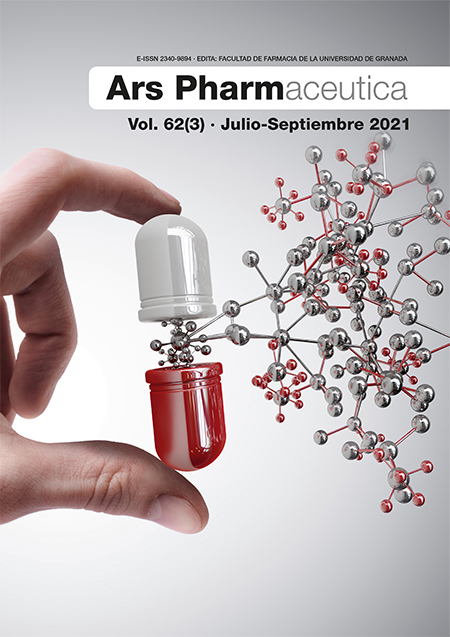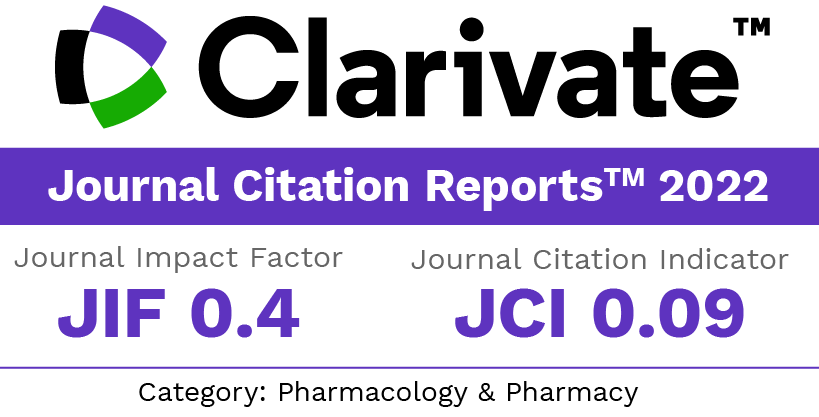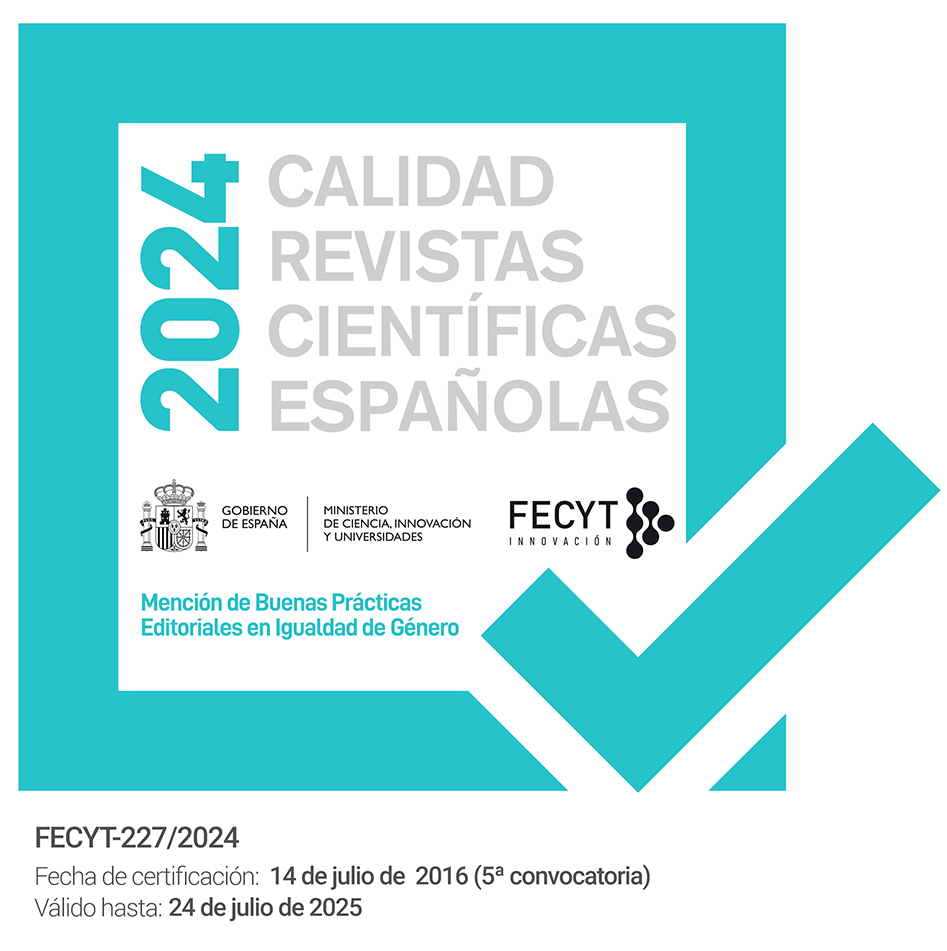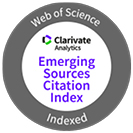Preparation and characterization of topical solid lipid nanoparticles containing deferoxamine
DOI:
https://doi.org/10.30827/ars.v62i3.15493Keywords:
Deferoxamine mesylate, Solid Lipid Nanoparticles, Topical drug deliveryAbstract
Introduction: Deferoxamine mesylate increases hypoxia inducible factor-1 alpha transactivation by preventing iron-catalyzed reactive oxygen stress, so it can be used to improve diabetic ulcer healing. This study was undertaken to develop and study physicochemical properties of topical deferoxamine-loaded solid lipid nanoparticles.
Method: Solid lipid nanoparticles were prepared using cold homogenization technique and full factorial design to evaluate the effect of surfactant type and amount of lipid. In-vitro characterization of formulations including particle size and distribution, thermal behavior using Differential Scanning Calorimetry, entrapment efficiency, and release profile were carried out.
Results: The results showed an acceptable range of particle size (2.88–174 nm), a narrow size distribution, and an average of 60% for drug entrapment efficiency which is significant for a hydrophilic drug. The results from release study showed an initial burst release followed by a slow and prolonged manner. Differential Scanning Calorimetry results also confirmed the results obtained from loading and release evaluations. The best formulation which had a high level of drug loading and the lowest drug release rate contained compritol and oleic acid in the amount of 8% of the total formula, as well as tween 80 and lecithin as a mixture of surfactants.
Conclusions: The study demonstrated deferoxamine could be loaded in solid lipid nanoparticles to deliver topically.
Downloads
References
Yih-Kuen Jan, Shen Sa, Robert D. Foreman, William J. Ennis. Skin blood flow response to locally applied mechanical and thermal stresses in the diabetic foot. Microvasc Res. 2013; 89: 40–46. Doi10.1016/j.mvr.2013.05.004
Dominik D, Evgenios N, Victor W. Wong, Zeshaan N. Maan, Robert C. Rennert, Inayathullah M, et al. Transdermal deferoxamine prevents pressure-induced diabetic ulcers. PNAS 6, 2015; 112 (1): 94-99. Doi:10.1073/pnas.1413445112.
Iranian National Formulary, 4th Edition, Spring 86, 2005. 6 p. [Persian]
David B. Hom, George S. Goding, Jr, Julie A. Price, Kerri J. Pernell, Robert H. Maisel. The effects of conjugated deferoxamine in porcine skin flap. John Wiley & Sons, Inc. Head Neck 2000; 22: 579-84.
Dragsten PR, Hallaway PE, Hanson GJ, Berger AE, Bernard B, and Hedlund Bo E. First human studies with a high-molecular-weight iron chelator. J Lab Clin Med 2000; 57-65.
Lazaridou M, Christodoulou E, Nerantzaki M, Kostoglou M, Dimitra A Lambropoulou, Katsarou A, et al. Formulation and In-Vitro Characterization of Chitosan-Nanoparticles Loaded with the Iron Chelator Deferoxamine Mesylate (DFO). Pharmaceutics 2020; 12: 238. doi: 10.3390/pharmaceutics12030238.
Hejazi S, Safari O, Arjmand R, Qorbani M, Pourrostami K, Safari AM, et al. Effect of Combined versus Monotherapy with Deferoxamine and Deferiprone in Iron Overloaded Thalassemia Patients: a Randomized Clinical Trial. Int J Pediatr. 2016; 4 (6): 1959-65.
Thanh D, Tecilazich F, Kafanas A, Doupis J, Gnardellis C, Leal E, et al. Mechanisms Involved in the Development and Healing of Diabetic Foot Ulceration. Diabetes. 2012; 61: 2937-47. doi:10.2337/db12-0227
Warren Clayton JR, Tom AE. A review of the pathophysiology, classification, and treatment of foot ulcers in diabetic patients. American Diabetes Association (R) Inc 2009.
Küchler S, Radowski Michal R, Blaschke T, Dathe M, Plendl J, Haag R, et al. Nanoparticles for skin penetration enhancement – A comparison of a dendritic core-multishell-nanotransporter and solid lipid nanoparticles Eur J Pharm Biopharm. 2009; 71: 243-50. doi:10.1016/j.ejpb.2008.08.019.
Mehnert W, Mader K. Solid lipid nanoparticles Production, characterization and applications. Ad Drug Del Rev. 2012; 47: 165-96. doi:10.1016/j.addr.2012.09.021
Rainer H. Mu¨ller, Ma¨der K, Gohla S. Solid lipid nanoparticles (SLN) for controlled drug delivery – a review of the state of the art. Eur J Pharm Biopharm. 2000; (50): 161–77.
Jee J-P, Lim S-J, Jeong-Sook Park, Chong-Kook Kim. Stabilization of all-trans retinol by loading lipophilic antioxidants in solid lipid nanoparticles. Eur J Pharm Biopharm. 2006; 63: 134-39. doi:10.1016/j.ejpb.2005.12.007.
Wissing SA, Kayser O, Mu¨ller RH. Solid lipid nanoparticles for parenteral drug delivery. Adv Drug Deliv. Rev. 2004; 56: 1257-72. doi:10.1016/j.addr.2003.12.002.
Wissing SA, Müller RH. Cosmetic applications for solid lipid nanoparticles (SLN). Int J Pharm. 2003; 254: 65-68. doi:10.1016/S0378-5173(02)00684-1.
Weiss J, Decker Eric A, McClements D Julian, Kristbergsson K, Helgason T, Awad T. Solid Lipid Nanoparticles as Delivery Systems for Bioactive Food Components. Food Biophysics 2008; 3: 146-54. doi:10.1007/s11483-008-9065-8.
Coppert TM, Muller RH. Adsorption kinetics of plasma proteins on solid lipid nanoparticles for drug targeting. Int J Pharm. 2005; 302: 172-86. doi:10.1016/j.ijpharm.2005.06.025.
Ramteke K.H, Joshi SA, Dhole SN. Solid Lipid Nanoparticle: A Review. IOSR J Pharmacy. 2012; 2 (6): 34-44.
Sanaa A. El-Gizawya, Ahmed Nouhb, Sameh Saberc, Ahmed Y. Kira. Deferoxamine-loaded transfersomes accelerates healing of pressure ulcers in streptozotocin-induced diabetic rats. JDDST. 2020; 58: 101732. doi:10.1016/j.jddst.2020.101732
Si-Qian G, Chen Ch, Jun-Jun L, Ying L, Xiao-Qian N, Dan-Ping Zh, et al. Co-delivery of deferoxamine and hydroxysafflor yellow A to accelerate diabetic wound healing via enhanced angiogénesis. Drug Deliv. 2018; 25 (1): 1779-89. doi:10.1080/10717544.2018.1513608
Muller-Goymann CC. Physicochemical characterization of colloidal drug delivery systems such as reverse micelles, vesicles, liquid crystals and nanoparticles for topical administration. Eur J Pharm Biopharm. 2004; 58: 343-56. doi:10.1016/j.ejpb.2004.03.028.
Mukherjee S, Ray S, Thakur RS. Solid Lipid Nanoparticles: A Modern Formulation Approach in Drug Delivery System. Indian J Pharm Sci. 2009;71(4): 349-58.
Fanga CL, Al-Suwayehb SA, Fang JY. Nanostructured Lipid Carriers (NLCs) for Drug Delivery and Targeting. Recent Pat Nanotechnol. 2013; 7: 41-55.
Downloads
Published
How to Cite
Issue
Section
License
Copyright (c) 2021 Ars Pharmaceutica (Internet)

This work is licensed under a Creative Commons Attribution-NonCommercial-ShareAlike 4.0 International License.
The articles, which are published in this journal, are subject to the following terms in relation to the rights of patrimonial or exploitation:
- The authors will keep their copyright and guarantee to the journal the right of first publication of their work, which will be distributed with a Creative Commons BY-NC-SA 4.0 license that allows third parties to reuse the work whenever its author, quote the original source and do not make commercial use of it.
b. The authors may adopt other non-exclusive licensing agreements for the distribution of the published version of the work (e.g., deposit it in an institutional telematic file or publish it in a monographic volume) provided that the original source of its publication is indicated.
c. Authors are allowed and advised to disseminate their work through the Internet (e.g. in institutional repositories or on their website) before and during the submission process, which can produce interesting exchanges and increase citations of the published work. (See The effect of open access).























